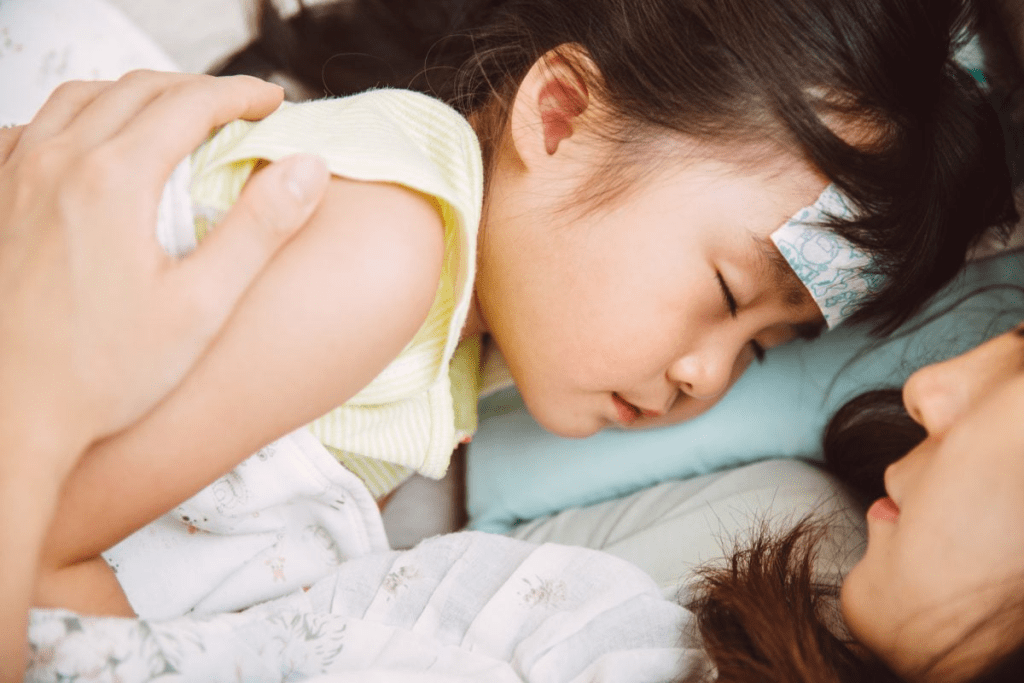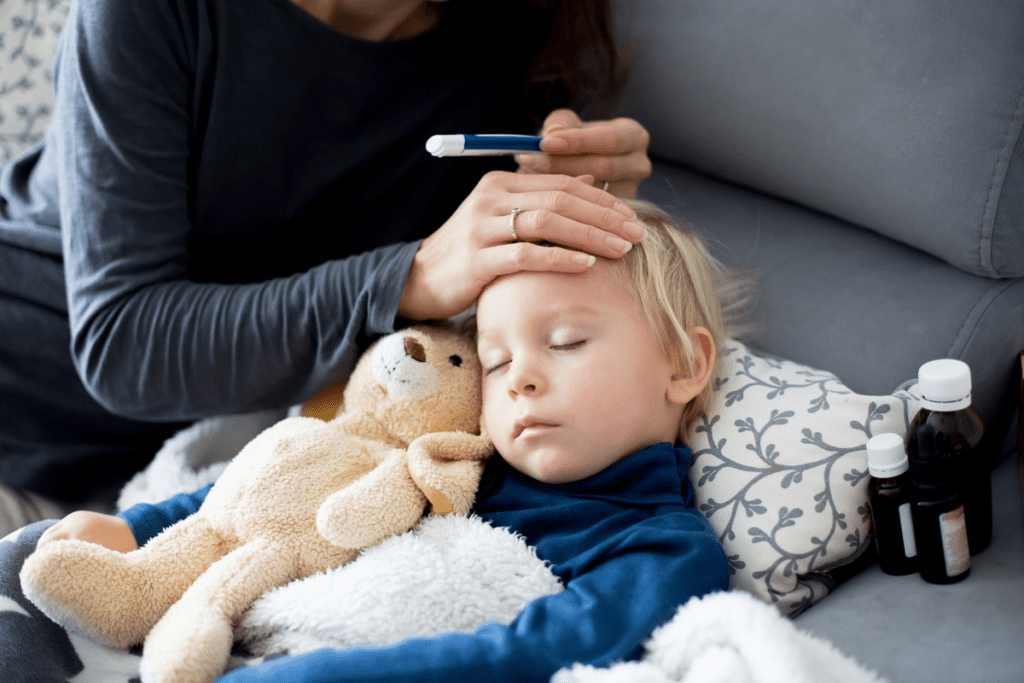Last Updated on November 26, 2025 by Saadet Demir
As a parent, it’s normal to worry when your toddler has a fever. Many parents often ask what temperature is a fever. A fever is when your child’s body temperature is 100.4 °F (38 °C) or higher. Fever in Children is common and often comes from infections. Knowing when to get medical help is key to your child’s health and your peace of mind.
Fevers can worry parents, but knowing the facts and red flags helps a lot. Remember, Fever in Children is a natural defence against infection and usually goes away by itself. But knowing when to get medical help is important for making the right choices.

As a parent, it’s normal to worry when your toddler has a fever. Knowing what temperature is considered a fever can ease your mind. Fever in Children is common in young kids. Understanding how Fever in Children works helps you know what to do next.
Normal body temperature is between 97 to 100 degrees Fahrenheit. It’s important to remember that body temperature changes throughout the day. It’s usually lower in the morning and higher in the late afternoon or evening. Understanding these natural changes helps parents recognize when Fever in Children may be present.
Fever in children is not an illness but a sign that the body is fighting an infection. When the body finds a virus or bacteria, it raises its temperature. This makes it harder for germs to grow and multiply, helping the body fight the infection.
Key functions of fever include:
Fever in children can be caused by many things, such as viral and bacterial infections. Some common causes include:
Fever in children worries parents a lot. It means different things at different ages. As kids get older, their immune systems get stronger. But some ages are more at risk for serious infections.
Infants under 3 months are at high risk for fever. Even a small fever can mean a serious infection. The American Academy of Pediatrics says these babies need to see a doctor right away if they have a fever over 100.4 °F (38 °C).
They need quick medical help because their immune systems are not fully grown yet.
“The younger the infant, the more cautious parents should be with fever,” says a pediatrician. “It’s always better to err on the side of caution and consult with a healthcare professional.”
Toddlers and older kids have different concerns with fever. It depends on how they feel, if they have other symptoms, and how high the fever is. Fever usually means the body is fighting an infection. Recognizing how Fever in Children varies by age helps parents understand what signs to watch for and when to take action.
But, very high fevers or ones with other bad symptoms need a doctor’s check-up.
When thinking about when a fever is too high for a child, look at more than just the temperature. A fever over 104 °F (40 °C) is usually too high. It needs close watching or a doctor’s visit if there are other bad signs.
Knowing about fever in kids and the risks at different ages helps parents decide when to get medical help.

It’s important for parents to know when a toddler’s fever needs medical help. Fever can be a sign of an infection or illness. Some cases need an immediate medical check-up.
A fever is high when it’s over 39 °C (102.2 °F). If your toddler’s fever is above this, watch them closely. A fever over 40 °C (104 °F) is a medical emergency and needs quick attention.
Also, how long the fever lasts matters. If it lasts more than three days, see a doctor. This can mean a serious infection.
Some symptoms with fever are warning signs. These include:
Watch your child’s behaviour and overall condition. If you see these symptoms, get medical help right away.
Some fevers can mean serious problems. If your child shows these symptoms, get help fast:
Trust your instincts as a parent. If you think your child’s condition is getting worse or too much to handle at home, get professional help.
Managing fever at home means taking the right steps. This includes checking the temperature, keeping your child comfortable, and using medications safely. It is important to stay calm and follow a plan to care for your child when they have a fever. Understanding how Fever in Children behaves helps parents make informed decisions while providing comfort and safety. When dealing with Fever in Children, having a clear approach at home can ease stress and support your child’s recovery.
Getting an accurate temperature reading is the first step. For young kids, using a rectal thermometer is best. Digital thermometers are easy to use and quick. Make sure to follow the instructions for accurate readings.
Keeping your child comfortable and hydrated is key. Dress them in light clothes and make sure they rest. Offer plenty of fluids like breast milk, formula, water, or electrolyte drinks. Watch for signs of dehydration, like fewer wet diapers or dry mouth.
“Drinking enough water is important for your child’s recovery,” says an Expert pediatrician. “Encourage them to drink small amounts often to avoid dehydration.”
Medicines like acetaminophen or ibuprofen can help lower a fever. But it’s important to use them safely. Always follow the dosage on the label and talk to your pediatrician if you’re unsure. Never give aspirin to children because of the risk of Reye’s syndrome.

It is important to know when a toddler’s fever should be a concern. Understanding the right temperature range and how Fever in Children behaves helps parents feel more prepared. This knowledge makes caring for a sick child easier and less stressful.
Parents can feel more confident by knowing when to seek medical help and when simple home care is enough. They can also take steps at home to help their child feel better. This includes checking the temperature correctly, keeping the child comfortable, and using medicines safely. These are essential parts of managing Fever in Children with confidence.
By combining awareness with practical actions, parents can support their child effectively. Being informed and ready helps reduce stress and ensures the child receives the care they need.
A fever is when a child’s body temperature goes over 100.4 °F (38 °C). For toddlers, a rectal temperature above 100.4 °F (38 °C) is a fever.
Fever in young children often comes from infections, like viruses or bacteria. It can also happen as a reaction to shots. Teething might cause some fever, but it’s not usually very high.
Babies under 3 months are at high risk. A fever over 100.4 °F (38 °C) needs quick medical help. For babies 3-6 months, a fever over 102 °F (39 °C) is a worry.
To help your toddler’s fever at home, make sure they drink lots of fluids. Use a rectal or oral thermometer to check their temperature. A cool compress or lukewarm bath can help them feel better. You can also use fever-reducing medicines like acetaminophen or ibuprofen, but only with a doctor’s advice.
You should get medical help if your toddler’s fever is over 104 °F (40 °C). Also, if they have trouble breathing, a bad headache, stiff neck, or signs of dehydration. Look out for lethargy, irritability, or a rash too.
Yes, but always follow the dosage instructions and talk to your doctor first. Acetaminophen is okay for kids over 3 months. Ibuprofen is good for kids over 6 months.
The best way to check your toddler’s temperature is with a rectal thermometer. Oral thermometers work too, but might not be as accurate. Don’t use ear or temporal thermometers because they’re not reliable.
A high fever in toddlers is over 104 °F (40 °C). But, the risk level changes with age. Babies under 3 months are at high risk even at lower temperatures.
Subscribe to our e-newsletter to stay informed about the latest innovations in the world of health and exclusive offers!